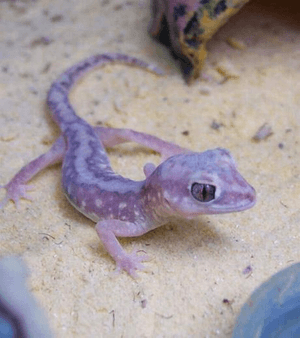Beaded gecko facts for kids
Quick facts for kids Beaded gecko |
|
|---|---|
 |
|
| Female | |
| Scientific classification | |
| Genus: |
Lucasium
|
| Species: |
damaeum
|
The beaded gecko (Lucasium damaeum) is a small lizard found only in Australia. It gets its name from the cool patterns on its back that look like chains of tiny beads. These geckos are active at night, searching for food across the dry Australian landscapes.
Contents
About the Beaded Gecko
What Does a Beaded Gecko Look Like?
The beaded gecko is a small lizard, usually about 7 centimeters (about 2.7 inches) long. Its body is reddish-brown on top. It has a pale, cream-colored stripe down its back, surrounded by patterns that look like chains of beads. This is how it got its name!
Its limbs and body have scattered dark brown spots. The gecko has a rounded snout. Its eyes are quite large, with a thin vertical pupil during the day. At night, the pupil becomes round and full.
How Do They See and Clean Their Eyes?
Beaded geckos have a white or cream upper eyelid. However, this eyelid cannot cover or clean their eyes. Instead, their eyes are covered by clear, protective scales. To keep their eyes clean, they use their long, flat tongue to wipe them.
What About Their Tail and Feet?
The tail of a beaded gecko looks like a natural extension of its body. An original tail will have patterns similar to the body. But if a gecko loses its tail and grows a new one, the new tail might be plain brown or have darker spots.
The toes of a beaded gecko are flat and do not have sticky pads. They are usually whitish. Their feet are not made for climbing, so these geckos stay on the ground.
When Are They Active?
Beaded geckos are nocturnal animals. This means they hide during the day to stay safe and cool. When night falls, they come out to hunt for food. They can travel long distances in the dark.
Where Do Beaded Geckos Live?
Beaded Gecko Habitat
Beaded geckos are found in the dry, arid (very dry) and semi-arid climate (partially dry) areas of mainland Australia. You can find them in all Australian states and the Northern Territory.
Life in the Wild
What Kind of Places Do They Live In?
The beaded gecko is a terrestrial animal, meaning it lives on the ground. It can be found in many dry desert habitats across Australia. These include savannah woodlands and sandhills covered with spinifex grass.
How Do They Survive in the Desert?
During the day, these geckos use holes made by insects and spiders as shelters. This keeps them safe from predators and the hot sun. At night, they come out to hunt in open areas. They are fast movers and cover large areas looking for food.
How Do Beaded Geckos Reproduce?
Laying Eggs
Beaded geckos are oviparous, which means they lay eggs instead of giving birth to live young. Female geckos usually lay two eggs at a time.
Breeding Season
Like most Australian reptiles, geckos have a special breeding season. For beaded geckos, this is from late September to December. Male geckos have special organs for reproduction.
What Do Beaded Geckos Eat?
Their Diet
Beaded geckos, like most small lizards, mainly eat insects. They have short, fine teeth around their jaws. However, they don't chew their prey. Instead, they crush it before swallowing.
What Threats Do They Face?
Dangers to Beaded Geckos
Beaded geckos face several threats in the wild. These include:
- Loss of habitat: When their natural homes are destroyed or changed.
- Feral predators: Animals like wild dogs, cats, and foxes that hunt them.
Images for kids


